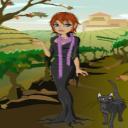Yahoo Answers is shutting down on 4 May 2021 (Eastern Time) and the Yahoo Answers website is now in read-only mode. There will be no changes to other Yahoo properties or services, or your Yahoo account. You can find more information about the Yahoo Answers shutdown and how to download your data on this help page.
Definition please...?
Can anyone please tell me the definition for the word overlocker, a term used in fabric technology and sewing?
Thanks! Your help is much appreciated.
7 Answers
- Anonymous1 decade agoFavourite answer
An overlock stitch sews over the edge of one or two pieces of cloth for edging, hemming or seaming. Usually an overlock sewing machine will cut the edges of the cloth as they are fed through (such machines are called ‘sergers’), though some are made without cutters. The inclusion of automated cutters allows overlock machines to create finished seams easily and quickly. An overlock sewing machine differs from a lockstitch sewing machine in that it utilizes loopers fed by multiple thread cones rather than a bobbin. Loopers serve to create thread loops that pass from the needle thread to the edges of the fabric so that the edges of the fabric are contained within the seam. Overlock sewing machines usually run at high speeds, from 1000 to 9000 rpm, and most are used in industrial setting for edging, hemming and seaming a variety of fabrics and products. Overlock stitches are extremely versatile, as they can be used for decoration, reinforcement, or construction. Overlocking is also referred to as “overedging”, “merrowing” or “serging”. Though “serging” technically refers to overlocking with cutters, in practice the four terms are used interchangeably.
Overlock machine
History
Overlock stitching was invented by the Merrow Machine Company in 1881.
J. Makens Merrow and his son Joseph Merrow were the owners of a knitting mill established in Connecticut in 1838, who developed a number of technological advancements to be used in the mill’s operations. Merrow's first patent was a machine for crochet stitching. Merrow still produces crochet machines based on this original model. This technology was a starting point for the development of the overlock machine, patented by Joseph Merrow in 1889. Unlike standard lockstitching, which uses a bobbin, overlock sewing machines utilize loopers to create thread loops for the needle to pass through, in a manner similar to crocheting. Merrow's original three-thread overedge sewing machine is the forerunner of contemporary overlocking machines. Over time, the Merrow Machine Company pioneered the design of new machines to create a variety of overlock stitches, such as two, and four-thread machines, the one-thread butted seam, and the cutterless emblem edger.
A landmark lawsuit between Wilkox & Gibbs and the Merrow Machine Company in 1905 established the ownership and rights to the early mechanical development of overlocking to the Merrow Machine Company.
Throughout the early 19th Century the area of Connecticut, USA and New York USA were the centers of textile manufacturing & machine production. Consequently many overlock machine companies established themselves in the North East.
In 1964 Juki Corporation was formed; a precursor of the modern industrial overlock sewing machine company. Throughout the 1980s Japanese and Chinese sewing machine production came to dominate the industry.
Today, The Merrow Sewing Machine Company is one of approximately 12 major global brands of overlock sewing machines. And one of perhaps 200 manufacturers of overlock sewing machines. The two most common are Juki and Brother.
In the United States the term "overlocker" has largely been replaced by "serger" but in other parts of the world (Australia, UK) the term "overlocker" is still in use.
Home Overlocking
Following the development of the industrial overlock machines, many companies began competing for the home market. The development and formation of the stitch are similar to the industrial models with some significant exceptions.
The home machine sews at approximately 800 stitches per minute (spm) whereas the industrial models sew up to 9500 spm.
Home machines are designed to sew several stitch types (variations of the overlock) whereas the industrial models are designed to sew one type.
Types of overlock stitches
Overlock stitches are classified in a number of ways. The most basic classification is by the number of threads used in the stitch. Industrial overlock machines are generally made in 1, 2, 3, 4, or 5 thread formations. Each of these formations has unique uses and benefits: 1-thread formations are used for end-to-end seaming, or ‘butt-seaming’. Two- and three-thread formations, also known as ‘merrowing’, are the most common, used for edging and seaming, especially on knits and wovens. Four-thread formations are called mock safety stitches and create extra strength while retaining flexibility. 5-thread formations, which utilize 2 needles, are called safety stitches, creating a very strong seam used for apparel manufacturing.
1-thread, 5/8” wide, 12 stitches per inch 2-thread, 1/8” wide, 20 stitches per inch, with differential feed 4-thread, 5/32” wide, 17 stitches per inch 3-thread, ¼” wide, 7 stitches per inch
Variability among the stitches
The main variables in the types of overlock stitches are the number of threads, the stitch eccentric, and the stitch width. The number of threads varies from 1 to 5. The stitch eccentric indicates how many stitches per inch there are, which is adjustable and can vary widely within one machine. Different stitch eccentrics create more or less dense and solid-looking edges. The stitch width indicates how wide the stitch is from the edge of the fabric. Lightweight fabrics often require a wider stitch to prevent pulling.
Adding extra variation in stitch types is the ‘differential feed’ feature, which allows feed to be adjusted; extra-fast feed creates a ruffled or ‘lettuce-leaf’ effect. Finally, some merrowing machines contain parts to roll the fabric edge into the stitch for added durability.
The formation of an overlock stitch
When the needle enters the fabric, a loop is formed in the thread at the back of the needle.
As the needle continues its downward motion into the fabric, the lower looper begins its movement from left to right. The tip of the lower looper passes behind the needle and through the loop of thread that has formed behind the needle.
The lower looper continues along its path moving toward the right of the serger. As it moves, the lower thread is carried through the needle thread.
While the lower looper is moving from left to right, the upper looper advances from right to left. The tip of the upper looper passes behind the lower looper and picks up the lower looper thread and needle thread.
The lower looper now begins its move back into the far left position. As the upper looper continues to the left, it holds the lower looper thread and needle thread in place.
The needle again begins its downward path passing behind the upper looper and securing the upper looper thread. This completes the overlock stitch formation and begins the stitch cycle all over again.
Usages of the overlock stitch
Overlock stitches are used for different kinds of seams, usually distinguished by the number of threads used.
1-thread: End-to-end seaming of piece goods for textile finishing.
2-thread: Finishing seam edges, stitching flatlock seams, stitching elastic and lace to lingerie, and hemming.
3-thread: Sewing pintucks, creating narrow rolled hems, finishing fabric edges, Decorative edging, and seaming knit or woven fabrics.
4-thread: Decorative edging and finishing, seaming high-stress areas.
5-thread: Seam construction in apparel manufacturing.
Though overlock stitches are traditionally used for edging and light seaming, the Merrow Sewing Machine Company has explored many unique and surprising applications for overlock stitches and has designed machines to fit these applications.
Some examples of applications are:
Sewing netting
Butt-seaming
Flat-locking
Edging emblems
Pearl stitching
Rolled hemming
Decorative edging
http://www.answers.com/overlocker?cat=technology&g...
♥
- 1 decade ago
That pretty much explains it as well as it can be explained, hope it helps =]
An overlock stitch sews over the edge of one or two pieces of cloth for edging, hemming or seaming. Usually an overlock sewing machine will cut the edges of the cloth as they are fed through (such machines are called ‘sergers’), though some are made without cutters. The inclusion of automated cutters allows overlock machines to create finished seams easily and quickly. An overlock sewing machine differs from a lockstitch sewing machine in that it utilizes loopers fed by multiple thread cones rather than a bobbin. Loopers serve to create thread loops that pass from the needle thread to the edges of the fabric so that the edges of the fabric are contained within the seam. Overlock sewing machines usually run at high speeds, from 1000 to 9000 rpm, and most are used in industrial setting for edging, hemming and seaming a variety of fabrics and products. Overlock stitches are extremely versatile, as they can be used for decoration, reinforcement, or construction.
Source(s): Wiki - Eden*Lv 71 decade ago
An overlock stitch sews over the edge of one or two pieces of cloth for edging, hemming or seaming. Usually an overlock sewing machine will cut the edges of the cloth as they are fed through (such machines are called ‘sergers’), though some are made without cutters. Overlock stitches are extremely versatile, as they can be used for decoration, reinforcement, or construction.
Overlocking is also referred to as “overedging”, “merrowing” or “serging”. Though “serging” technically refers to overlocking with cutters, in practice the four terms are used interchangeably.
- 1 decade ago
I also sew. My guess is that an 'overlocker' is a slang term for a 'serger' or machine that does the overlock or overcast stitch.
From http://dictionary.reference.com/browse/serger
"serge serged, serg·ing, serg·es
To overcast (the raw edges of a fabric) to prevent unraveling."
- 1 decade ago
It's a machine that does overlock stitching. Here's a video, you can see what it does: http://www.youtube.com/watch?v=EMTrLg3jElc&feature...
"One video is worth a thousand words." 8^D or was that a "picture?" 8]
- JJLv 41 decade ago
An overlocker is a machine that is used to overlock stitching so as to make it stronger.
Here is a bit more:
- 1 decade ago
This is a guess, but my guess is its the way the stitching is sewn. Overlock eachother maybe?





